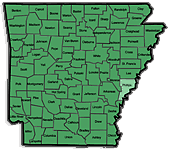|

Phillips County was formed on May 1, 1820, by the Territorial Legislature, and
was named for Sylvanus Phillips, the area’s first-known white settler and representative to the first Territorial Legislature.
The county seat is Helena. The landscape of Phillips County is rich, flat, Delta farmland. The Mississippi River forms the
eastern boundary. Agriculture and agricultural chemicals have formed the basis of Phillips County’s economy along with
sporting and recreation on its many lakes and waterways. St. Francis National Forest, the smallest of the national forests,
is a semi-tropical haven for countless species of wildlife and vegetation. White River National Wildlife Refuge contains ox-bow
lakes deposited by the White River and has some of the finest bass-fishing waters to be found. The refuge is home to some
227 species of non-game birds, 48 species of reptiles and amphibians, and 30 species of mammals. Phillips is an old county
with rich heritage. Nearly two dozen sites in the county are on the National Register of Historical Places. Phillips County
Courthouse is a stately old building. At the northwest corner of the two-story building is a bronze statue of a World War
I doughboy with a fixed bayonet standing in the middle of the intersection of the adjoining redbrick paved streets. The Courthouse
stands just inside the levee of the Mississippi River, and a U. S. Coast and Geodetic Survey benchmark located at the northwest
corner of the building shows that the elevation of the small courtyard in the fertile delta is 189.55 feet above sea level.
|

